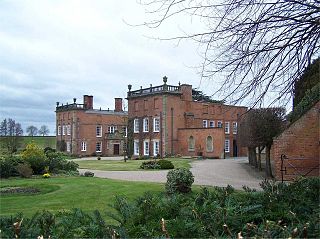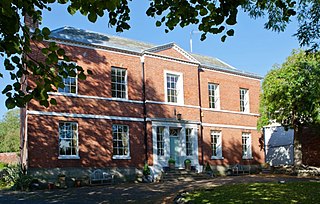
Alfreton is a town and civil parish in the Amber Valley district of Derbyshire, England. The town was formerly a Norman Manor and later an Urban District. The population of the Alfreton parish was 7,971 at the 2011 Census. The villages of Ironville, Riddings, Somercotes and Swanwick were historically part of the Manor and Urban District, and the population including these was 24,476 in 2001.

Major Charles Henry John Chetwynd-Talbot, 20th Earl of Shrewsbury, 20th Earl of Waterford, 5th Earl Talbot, KCVO, styled Viscount Ingestre from 1868 to 1877, was a British peer.
Benjamin Outram was an English civil engineer, surveyor and industrialist. He was a pioneer in the building of canals and tramways.
Arthur Ronald Nall Nall-Cain, 2nd Baron Brocket was a Conservative Party politician in the United Kingdom.

Evelyn Pierrepont, 2nd Duke of Kingston-upon-Hull, KG was an English nobleman and landowner, a member of the House of Lords. He was the only son of William Pierrepont, Earl of Kingston-upon-Hull (1692–1713) and his wife, Rachel Bayntun (1695–1722).

Major-General Henry Gladwin was a British army officer in colonial America and the British commander at the Siege of Fort Detroit during Pontiac's Rebellion in 1763. He served in the disastrous campaign of Edward Braddock and in other actions in the French and Indian War but is best remembered for his defense of Detroit in Pontiac's Rebellion.

Sutton Scarsdale Hall is a Grade I listed Georgian ruined stately home in Sutton Scarsdale, just outside Chesterfield, Derbyshire.

Dorney Court is a grade I listed early Tudor manor house, dating from around 1440, located in the village of Dorney, Buckinghamshire, England. It is owned and lived in by the Palmer family.

This is a list of Sheriffs of Derbyshire from 1567 until 1974 and High Sheriffs since.

Samuel Charles Allsopp, 2nd Baron Hindlip, was a British businessman and Conservative politician who sat in the House of Commons between 1873 and 1887 when he inherited the peerage.
The Cave, later Cave-Browne, later Cave-Browne-Cave Baronetcy, of Stanford in the County of Northampton, is a title in the Baronetage of England.
Ladbroke Hall is an 18th-century country house, now converted into residential apartments, situated at Ladbroke, near Southam, Warwickshire, England. It is a Grade II listed building.

Hassop Hall is a 17th-century country house near Bakewell, Derbyshire, which was operated as a hotel until it closed on 29 September 2019. It is a Grade II* listed building.

Longford Hall is a 16th-century country house at Longford in the Dales district of Derbyshire, England. It is a Grade II* listed building.

Callow Hall Hotel, Ashbourne, Derbyshire, is a house of historical significance and is listed on the English Heritage Register at Grade II. It was built from 1849 to 1852 by H. J. Stevens for John Goodwin Johnson, a local magistrate. It was a private residence for over a century and then became a hotel in 1982. It is still a hotel which provides accommodation and restaurant services and caters for special events particularly weddings.
Charles Goodwin (1658–1731) was an English landowner who lived in the historic house of Rowfant in Sussex and served as High Sheriff of Sussex.
Alfred Miller Mundy was an English military officer in colonial New South Wales, who after leaving the army served in the Legislative Council of South Australia, from 15 June 1843 to 14 May 1849.

Breedon Hall, Breedon on the Hill in north-west Leicestershire, is a house of historical significance and is listed on the English Heritage Register. In 1620 it was a small timber framed cottage. Soon after it was bought by the Curzon family and was successively enlarged until 1777 when it was given a new Georgian front. It was the ancestral home of the Curzons for over three centuries and then bought by the Shields family. Today it is owned by the Meynell family and provides bed and breakfast accommodation.

Ellen Morewood or Ellen Goodwin; Ellen Goodwyn; Mrs. George Morewood; Mrs. Henry Case-Morewood was an English colliery owner based at Alfreton Hall in Derbyshire. She unsuccessfully defended her right to mine under land adjacent to hers and she carried forward the Morewood name.
John Sneyd (1734–1809) was an English landowner, at Bishton Hall near Colwich, and Belmont Hall near Ipstones, Staffordshire, and High Sheriff of Staffordshire in 1763. He was a prominent citizen of Lichfield. He was known also as a botanist, agriculturist and tree-planter.



















